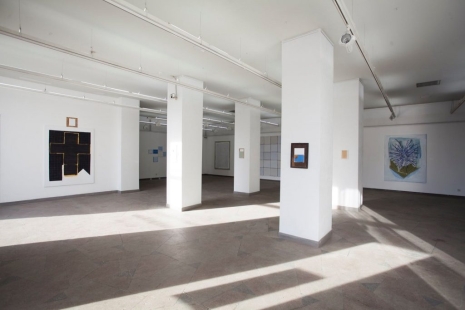The artworks exhibited in the exhibition are painted on mirror film, which allows the viewer to get involved in the plot through the reflection, merge with the painting and become part of it for a while. The reflective surface, often used in architecture (building facades and decoration), as well as in aviation, prompted the author to turn to the 1927 film “Metropolis” by the German director Fritz Lang, in which the image of a futuristic city inspired by Art Deco and the speed of technological change is drawn by these visions of the past (the director looked almost a century ahead at that time). In the plot of the film, one can see current problems, such as social inequality, the contrast between poverty and the good life, hints of artificial intelligence, and robotization, but it is also important to note that the majestic and monumental Metropolis, which symbolizes the future city prospects in the film, did not help to consolidate the splendor and luxury of Art Deco architectural style.
In the exhibition, the author examines the relationship between the present, past failures, and future expectations, using both specific images and the representational technique itself as a hint to other cultural texts and contexts. Here, the society living in an anxious age becomes important, its mistrust of the present time, and its desire to escape are answered – the distraction between nostalgia and hope. Apparently, the present time is implausible, abstract, creating a veil of illusion, mitigating inner confusion, maybe because what is present equates to artificiality. After all, in a world saturated with visual noise, where tangibility often tries to overshadow the intangible, ephemeral, not always recognizable silhouettes keep emerging, tempting the present to embrace the unknown.
The title of the exhibition, The Absence of the Present, is proposed to be understood in two main aspects: globally (political unrest, ecological catastrophes) or through a personal, psychological connection (nostalgia for the past, dissatisfaction with the quality of life, loss of a loved one, uncertainty of the future, lurking challenges). It is also useful to distinguish a certain period of time as a liminal state with a beginning and an end (according to some philosophers, such as Allan Watts, such a state can span a lifetime). Thus, at the junction of the present with the time “before” and “after”, nostalgia comes to the rescue: acting on the principle of self-preservation, it creates a transitory “between” state, separating it from the present time and creating a state of “absence”. Examining this phenomenon through a psychological prism, one can see the individual’s state of anxiety and confusion, seeking refuge in the content of thoughts: in the present, the past can provide comfort and the future can be confusing, or vice versa. Occupied by the inner world, the exterior becomes a transitory state, a stage of waiting in which the melting present ceases to matter. Taking a broader aspect of the present, society remains distracted by illusions, visions of a brighter and more fulfilling tomorrow are created, which must be waited for, so the counterargument manifests itself in the idealization of the past, a medium is created for the dispersed present. Using the same “what if?” principle, one can speculate about certain events, plots, historically review promises and losses, looking for their place in the present and returning their potential.
Gytis Arošius (b. 1996) – a painter who graduated from the Vilnius Academy of Arts in 2021 obtaining a master’s degree. His work, inspired by brutalist architecture, industrial building structures, and military transport, is recognizable by its monochromatic coloration, characteristic variations of dark blue shades. Arošius’s creative activity is based on retrofuturism, with the help of which the artist depicts the fear of impending disasters and their disastrous consequences. His work often includes elements of 20th-century utopian architecture, Brutalism, industrial constructions and technology, along with human figures losing their contours and drowning in dark landscapes. The painter constructs his paintings with the help of photographs taken by himself, in which he inserts images of non-existent, fictional objects or historical military vehicles used in the Cold War. Arošius creates a paranoid, anxious atmosphere and a sense of alienation with his paintings, his works combine the past, present, and future: in this way, he aims to find a rational basis for explaining the all-encompassing sense of decline and entropy. Currently, Gytis Arošius works in Vilnius, participates in solo and group exhibitions in Lithuania and abroad.
Organizer: Pamėnkalnio Gallery.
Sponsors: Lithuanian Council for Culture, Saulius Karosas Charity and Support Foundation, Vilnius City, Lithuanian Artists’ Association.
Partner: Vartai Gallery.





